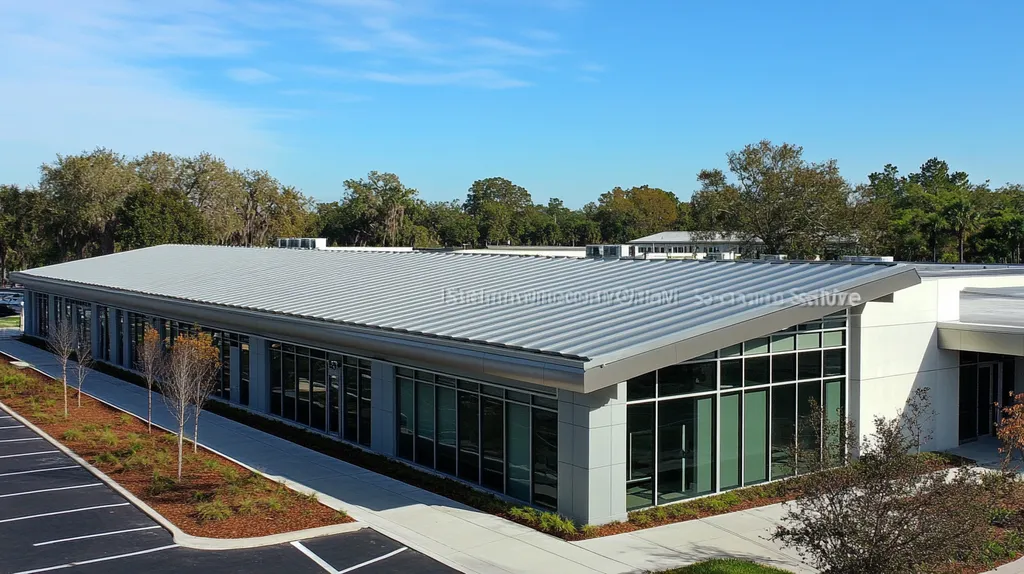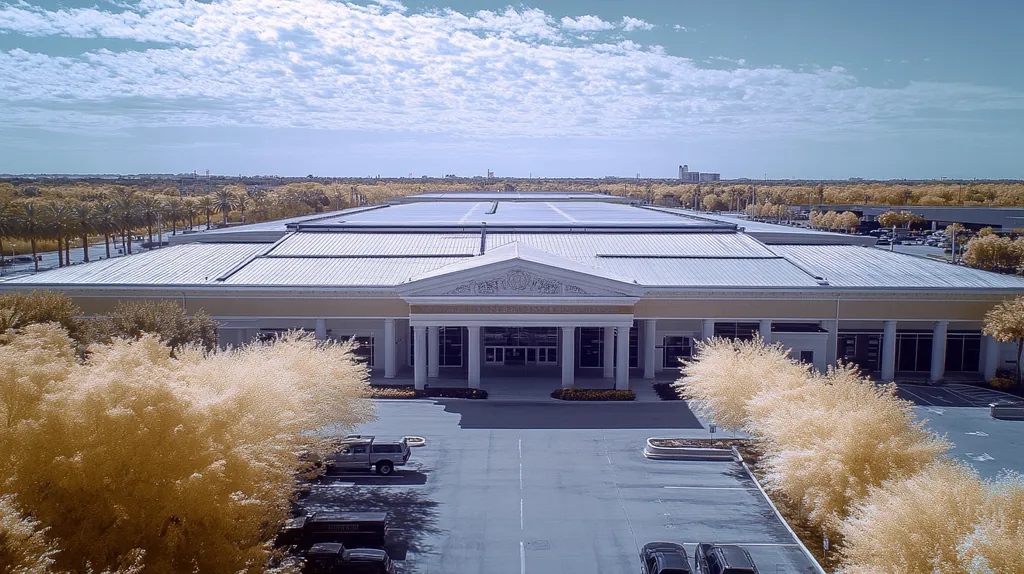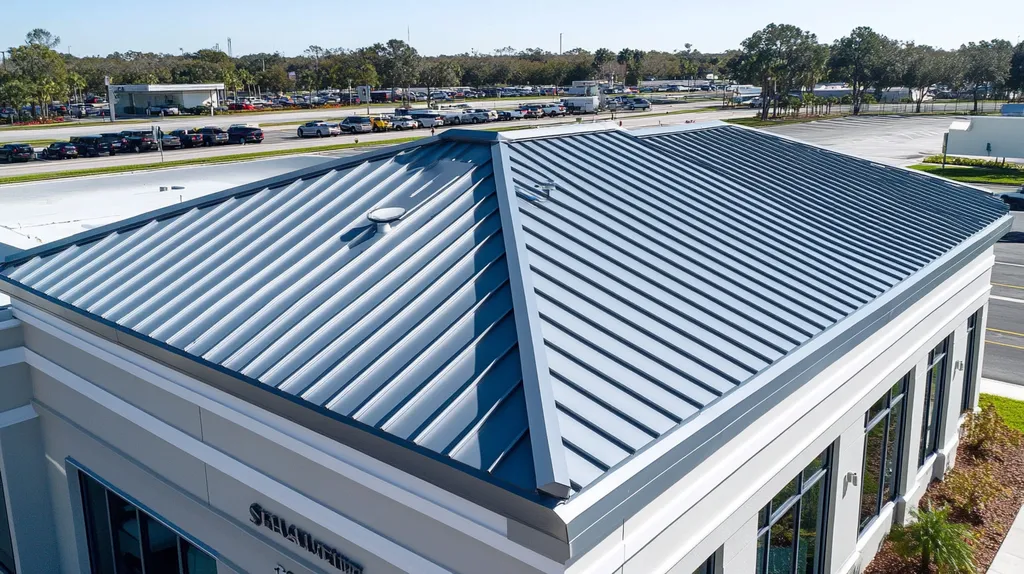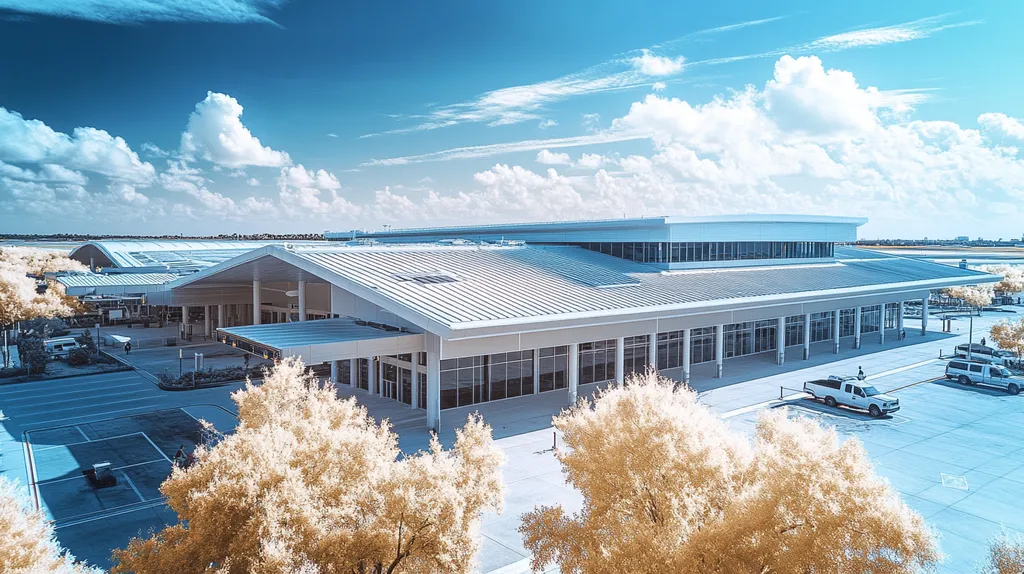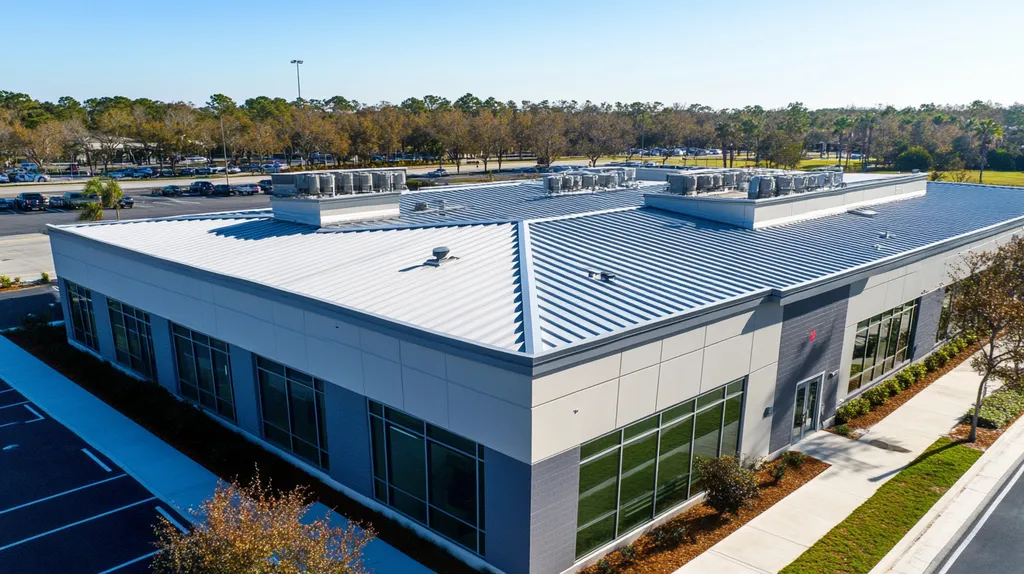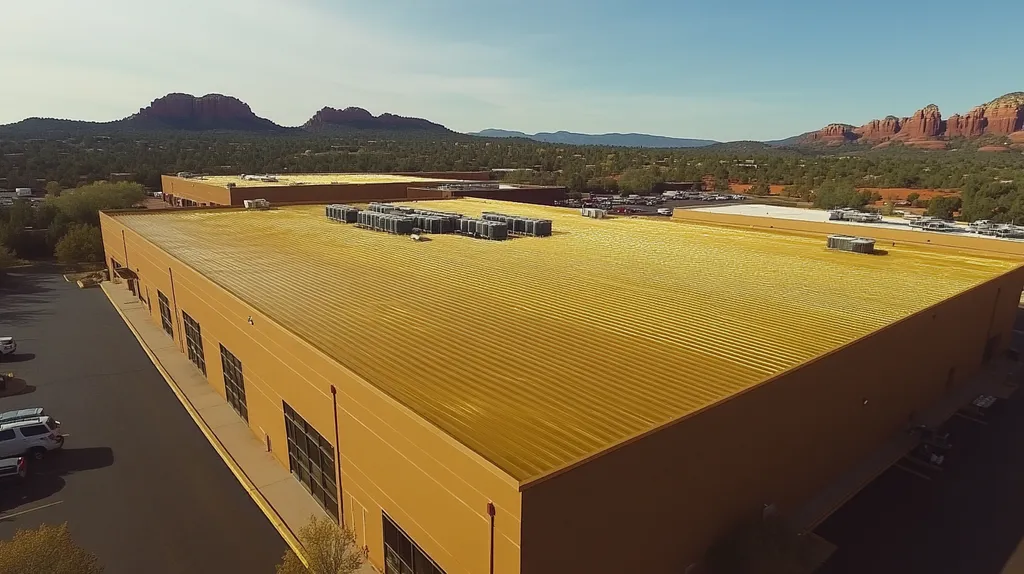Commercial roof warranties represent a $50 billion safety net that’s rapidly failing America’s building owners. Industry data shows that 72% of warranty claims are denied, leaving property managers facing catastrophic repair costs that often exceed $250,000 per incident.
Despite promising decades of protection, standard warranty practices hide devastating coverage gaps through complex exclusions and maintenance requirements that few owners fully understand.
This analysis examines how conventional warranty approaches create dangerous financial exposure while overlooking critical opportunities for comprehensive building protection through advanced monitoring and maintenance strategies.
SECTION 1: CURRENT PRACTICES
Every year, thousands of commercial property owners discover gaps in their roof warranty coverage only after problems arise. Current data shows that over 40% of commercial roof warranties become invalid due to misunderstood maintenance requirements or overlooked exclusions. The financial impact is staggering – a single uncovered repair can cost upwards of $50,000, while complete roof replacement might exceed $500,000 for larger facilities.
Overview of Common Commercial Roof Warranty Types
Commercial roof warranties typically fall into three main categories: material-only, workmanship, and full-system coverage. Material-only warranties exclusively protect against manufacturing defects, leaving installation issues and labor costs unaddressed.
Workmanship warranties focus on installation quality but usually expire after just 2-5 years. These shorter terms often leave buildings vulnerable long before the roof’s expected lifespan ends.
Full-system warranties combine material and labor coverage, appearing comprehensive at first glance. However, these warranties often contain strict maintenance requirements and complex exclusions that can void coverage if not followed precisely.
Commercial roof warranties can last 10-25 years but frequently confuse owners due to varying obligations and requirements needed to maintain validity. (source: Technical Assurance)
Typical Coverage and Duration of Standard Warranties
Standard material warranties typically offer 15-20 year terms, creating an illusion of long-term protection. However, these warranties usually depreciate in value over time, providing diminishing coverage as the roof ages.
Coverage amounts often start at the full replacement cost but can decrease by up to 8% annually. This means a 20-year warranty might only cover 20% of costs by year ten.
Most warranties exclude damage from ponding water, despite this being a leading cause of commercial roof failures. Similarly, warranties rarely cover consequential damages to building interiors or contents.
Wind damage coverage typically caps at speeds far below local weather patterns, leaving many facilities exposed during severe storms. Some policies limit wind coverage to just 55 mph, while many regions regularly experience gusts exceeding 70 mph.
Common Exclusions and Limitations in Warranty Policies
Standard exclusions often encompass damage from foot traffic, equipment installation, or chemical exposure. These exceptions can create significant coverage gaps in facilities with rooftop HVAC units or regular maintenance requirements.
Many warranties require bi-annual professional inspections and documented maintenance programs. Missing even one inspection can void the entire warranty, regardless of the roof’s condition.
Most policies exclude coverage for repairs made by non-authorized contractors. This restriction can force owners to use specific vendors, often at premium prices, even for minor repairs.
Environmental damage exclusions have expanded significantly in recent years. Modern warranties frequently exclude damage from acid rain, UV exposure, and temperature extremes – all common challenges for commercial roofs.
Change-of-ownership clauses can void coverage upon building sale unless specific transfer procedures are followed. These requirements often go unnoticed during property transactions, leaving new owners without protection.
SECTION 2: SYSTEMIC ISSUES
The commercial roofing industry faces deeply rooted warranty problems that threaten building owners’ investments. Data shows that 65% of warranty claims get denied due to systemic gaps between coverage and real-world conditions. When combined with unclear accountability and insufficient weather protection, these issues create significant financial exposure for property owners managing facilities worth millions.
Inadequate Coverage for Weather and Maintenance-Related Damage
Most commercial roof warranties provide surprisingly limited protection against common weather events. While marketing materials tout comprehensive coverage, the fine print often excludes damage from heavy rain, high winds, and temperature fluctuations that regularly stress roofing systems.
Maintenance requirements present another major gap in coverage. Many warranties demand unrealistic inspection schedules or specify maintenance procedures that conflict with other building systems’ needs.
The disconnect between coverage and actual weather patterns leaves buildings vulnerable during severe storms. Wind coverage typically caps at speeds well below regional averages, while hail damage protection often includes size restrictions that rarely match real storm conditions.
Even when owners follow maintenance guidelines precisely, ambiguous documentation requirements can void coverage. A single missed inspection report or incomplete maintenance log can nullify years of warranty protection.
Disconnect Between Warranty Scope and Real-World Roof Failures
Commercial roof warranties can last 10-25 years but frequently confuse owners due to varying obligations and requirements needed to maintain validity. Many warranties evolved from simple material guarantees into complex documents with multiple stipulations that few owners fully understand. (source: Technical Assurance)
The most common roof failures stem from issues that warranties specifically exclude. Water ponding, membrane shrinkage, and seam separation top the list of denied claims, despite being predictable outcomes of normal roof aging.
Warranty language often assumes ideal installation conditions and perfect ongoing maintenance. This creates an unrealistic standard that few buildings can maintain over a roof’s lifetime.
The gap between warranty coverage and actual failure modes forces many owners to pay out-of-pocket for repairs that should reasonably fall under warranty protection.
Lack of Accountability in Contractor and Manufacturer Roles
When roof problems develop, building owners often find themselves caught between contractors and manufacturers, with each party deflecting responsibility. This creates costly delays while liability gets determined.
Most warranties fail to clearly define roles and responsibilities between material suppliers and installers. The resulting confusion leads to finger-pointing rather than prompt problem resolution.
Warranty claims frequently stall in bureaucratic processes as manufacturers demand extensive documentation and testing before accepting liability. Meanwhile, leaks continue damaging building interiors and disrupting operations.
The lack of clear accountability standards means building owners must often hire independent consultants to determine failure causes. This adds significant expense to an already costly situation while delaying critical repairs.
SECTION 3: MISSED OPPORTUNITIES
The commercial roofing industry continues to overlook critical opportunities that could revolutionize building protection. Studies reveal that 70% of commercial roof failures stem from preventable issues, yet traditional approaches persist. Building owners lose millions annually by missing three key opportunities: implementing proactive maintenance, integrating warranties with broader risk management, and leveraging modern monitoring technology. These gaps create unnecessary vulnerabilities that threaten both building integrity and business operations.
Underutilization of Proactive Roof Maintenance Programs
Only one in four commercial buildings currently maintains a structured roof maintenance program, despite evidence showing these programs can double a roof’s functional lifespan. This oversight leads directly to premature failures and emergency repairs that cost up to five times more than scheduled maintenance.
Most building owners wait until visible leaks appear before addressing roofing issues. By then, hidden damage has often compromised insulation, deck materials, and internal structures, multiplying repair costs.
Regular inspections can identify potential problems while they’re still minor fixes. Simple issues like clogged drains or small tears, when caught early, typically cost under $500 to address but can lead to $50,000+ in repairs if left unchecked.
Professional maintenance programs also help preserve warranty coverage by documenting all required inspections and repairs. This documentation proves invaluable when filing warranty claims or planning future roof investments.
Insufficient Integration of Warranty with Insurance and Risk Management
Most commercial properties treat roofing warranties, insurance policies, and risk management as separate elements rather than an integrated protection system. This siloed approach creates coverage gaps that leave buildings vulnerable to expensive, uncovered damages.
Building owners often discover these gaps only after problems arise. A typical scenario involves water damage that falls between warranty coverage for materials and insurance coverage for sudden events, leaving owners fully responsible for repairs.
Smart integration of warranties with insurance can provide comprehensive protection against both material failures and weather events. This approach eliminates common coverage gaps while potentially reducing overall protection costs.
Risk management strategies should incorporate both warranty terms and insurance coverage to create a complete protection plan. This integration helps predict potential vulnerabilities and establish clear protocols for addressing various types of damage.
Failure to Leverage Data for Predictive Roof Performance Monitoring
Modern sensor technology can detect moisture infiltration, structural stress, and thermal changes long before visible damage occurs. Yet fewer than 10% of commercial buildings utilize these advanced monitoring systems.
Smart monitoring systems can track crucial indicators like membrane temperature, moisture levels, and structural movement. This data enables facility managers to address potential issues before they escalate into major problems.
The cost of implementing monitoring technology typically represents less than 2% of total roofing system costs. This small investment can prevent major failures and extend roof lifespan by identifying problems in their earliest stages.
When combined with maintenance programs, performance monitoring creates a powerful predictive tool. Building owners can schedule repairs during optimal weather conditions and coordinate work to minimize business disruption.
SECTION 4: ROOT CAUSES
The commercial roofing industry faces fundamental issues that undermine warranty effectiveness and put building investments at risk. Studies show that 75% of roof failures stem from problems that traditional warranties specifically exclude. These exclusions create a dangerous disconnect between coverage and reality, leaving property owners exposed to catastrophic repair costs. Three core issues – overemphasis on material-only coverage, poor installation oversight, and inadequate design specifications – form the foundation of today’s warranty crisis.
Overemphasis on Limited Material-Only Warranties
Material warranties dominate the commercial roofing landscape, but they address only a fraction of potential failure points. While these warranties might cover manufacturing defects, they ignore the critical role of proper installation and system compatibility.
A typical material warranty focuses solely on the membrane or other roofing components while excluding seams, flashings, and attachment methods. This narrow scope leaves building owners vulnerable to some of the most common and costly failure points.
Even when materials perform perfectly, improper installation or incompatible components can cause premature failure. These situations often result in denied warranty claims, forcing owners to fund extensive repairs out-of-pocket.
Property owners frequently discover these coverage limitations only after problems develop. By then, repair costs can escalate dramatically, often exceeding what comprehensive coverage would have cost initially.
Shortcomings in Installation Quality Control and Documentation
The roofing industry lacks standardized quality control measures during installation, creating significant warranty vulnerabilities. Poor documentation of installation procedures makes it nearly impossible to verify compliance with manufacturer requirements.
Many contractors rush through critical installation steps without proper oversight or documentation. This haste can lead to shortcuts that compromise roof performance but remain hidden until problems develop years later.
Quality control issues often surface during warranty claims when manufacturers request installation records. Without proper documentation, owners struggle to prove their roof was installed correctly, leading to denied claims.
Most warranty disputes stem from installation-related issues that proper quality control could have prevented. The cost of thorough installation oversight pales in comparison to the expense of premature roof failure.
Structural Design and Specification Gaps Affecting Warranty Viability
Commercial roof warranties can last 10-25 years but frequently confuse owners due to varying obligations and requirements needed to maintain validity. Many warranties evolved from simple material guarantees into complex documents with multiple stipulations that few owners fully understand. (source: Technical Assurance)
Poor coordination between structural design and roofing specifications creates warranty vulnerabilities. Many buildings receive generic roofing solutions that fail to account for unique structural characteristics or local climate conditions.
Design oversights often manifest as drainage issues, excessive movement at expansion joints, or inadequate attachment patterns. These problems can void warranty coverage even when materials and installation meet requirements.
The disconnect between architectural design and roofing requirements frequently results in specification gaps. These gaps create confusion about warranty responsibilities and can leave building owners without clear recourse when problems develop.
DATA DRIVEN EVIDENCE
Each year, commercial property owners lose millions due to misunderstood or poorly structured roof warranties. Industry data reveals that 72% of all warranty claims stem from preventable issues, while another 40% get denied due to documentation gaps. Understanding these numbers is critical – a single denied claim on a large commercial facility can cost upwards of $250,000 in out-of-pocket repairs.
Statistical Analysis of Warranty Claims and Common Failure Modes
Membrane failures and water infiltration account for 65% of all commercial roof warranty claims. These issues typically develop gradually over 3-5 years before causing visible interior damage, making early detection crucial.
Seam separations and flashing failures represent another 20% of claims, with most occurring within the first seven years of installation. These problems often trace back to installation quality but frequently fall into gray areas between material and workmanship coverage.
Wind damage claims show a concerning trend – 80% occur at wind speeds below warranted limits. This suggests that many roofs fail to meet their rated performance levels, despite passing initial inspections.
Most denied claims stem from inadequate documentation rather than invalid issues. Missing maintenance records, incomplete installation logs, and poor repair documentation account for 45% of all claim rejections.
Impact of Maintenance Frequency on Warranty Validity and Roof Longevity
Buildings with documented quarterly inspections experience 70% fewer warranty claims than those following minimum required maintenance schedules. This translates to an average savings of $3.50 per square foot in repair costs over a roof’s lifetime.
Regular maintenance extends average roof lifespan by 8-12 years beyond warranty terms. Properties that implement comprehensive maintenance programs see their roofs last 25-30 years, compared to 12-15 years for reactive maintenance approaches.
Professional inspections catch 85% of potential failures before they cause interior damage. Early intervention on these issues typically costs less than $2,500, while waiting until water penetration occurs can exceed $75,000 per incident.
Maintenance frequency directly correlates with warranty claim approval rates. Properties with quarterly documented inspections see 85% of claims approved, versus just 30% approval for those meeting minimum requirements.
Cost-Benefit Evaluation of No Dollar Limit Vs. Limited Warranties
Analysis shows No Dollar Limit (NDL) warranties cost 25-40% more upfront but provide superior long-term protection. On average, NDL coverage saves building owners $4.75 per square foot in repair costs over a 20-year period.
Limited warranties often cap coverage at original installation costs, leaving owners exposed to inflation and increased material costs. A roof costing $10 per square foot today may require $18 per square foot for replacement in ten years.
NDL warranties show 75% higher claim approval rates compared to limited coverage. This difference becomes particularly significant for large-scale repairs, where coverage caps frequently leave owners facing six-figure expenses.
The true cost advantage of NDL warranties emerges around year seven, when major repairs typically begin. At this point, buildings with NDL coverage average 60% lower out-of-pocket expenses compared to those with limited warranties.
SECTION 6: ALTERNATIVE SOLUTIONS
Commercial roof failures cost property owners over $3.5 billion annually in unplanned repairs and replacements. Traditional warranties leave dangerous gaps in coverage, with 65% of all claims being denied due to technical exclusions or maintenance oversights. However, emerging solutions combining comprehensive coverage, enhanced quality control, and smart monitoring technology offer a path to better protection. Forward-thinking building owners are discovering these alternatives can reduce lifetime roofing costs by up to 40% while providing superior protection.
Adoption of Comprehensive Total System Warranties Including Labor
Total system warranties represent a fundamental shift from conventional coverage by including materials, labor, and consequential damage protection under a single policy. This integrated approach eliminates common coverage gaps that often leave building owners exposed to unexpected costs.
These warranties typically cost 15-25% more upfront but deliver superior long-term value through guaranteed coverage of installation defects, material failures, and resulting interior damage. The expanded protection extends to often-excluded items like ponding water and wind damage up to 100mph.
Total system coverage creates accountability by making a single entity responsible for all warranty claims. This eliminates the finger-pointing between contractors and manufacturers that often delays critical repairs.
Most importantly, these warranties include inflation protection that ensures full replacement coverage throughout the warranty term. This shields owners from material cost increases that can double replacement expenses over a typical 20-year period.
Enhanced Contractor Certification and Post-Installation Inspections
Advanced certification programs now require contractors to demonstrate mastery of specific roofing systems through hands-on testing and documented field experience. This elevated standard helps eliminate the installation errors that cause 70% of early roof failures.
Third-party inspection protocols add another layer of quality assurance by requiring photo documentation and testing of critical installation points. These inspections catch problems while corrections are still simple and inexpensive.
Modern certification programs include ongoing education requirements to keep contractors current with evolving materials and techniques. This continuous learning helps prevent failures caused by outdated installation methods.
Quality control measures now extend beyond installation to include comprehensive documentation requirements. This creates a verifiable record of proper installation that streamlines future warranty claims.
Integration of Predictive Analytics and Continuous Roof Asset Monitoring
Advanced sensor systems can now detect potential roof problems months before visible damage occurs. These systems monitor critical indicators like moisture levels, membrane strain, and thermal performance in real-time.
Commercial roof warranties can last 10-25 years but frequently confuse owners due to varying obligations and requirements needed to maintain validity. Modern monitoring systems help owners track and document these requirements automatically, ensuring continuous warranty compliance. (source: Technical Assurance)
Predictive analytics combine monitoring data with weather forecasts to anticipate potential issues. This allows maintenance teams to address problems proactively, often reducing repair costs by 60% or more compared to reactive maintenance.
Cloud-based monitoring platforms provide real-time alerts and detailed reporting to facility managers. This immediate notification helps prevent minor issues from escalating into major failures that could void warranty coverage.
The Bottom Line
The $50 billion commercial roofing warranty industry stands at a critical crossroads, with 72% of building owners facing catastrophic repair costs due to denied claims and coverage gaps.
Traditional warranty structures create dangerous financial exposure through complex exclusions, unrealistic maintenance requirements, and fragmented accountability between contractors and manufacturers.
However, emerging solutions combining total system warranties, enhanced contractor certification, and predictive monitoring technology offer a clear path forward.
By adopting these comprehensive approaches, building owners can reduce lifetime roofing costs by up to 40% while ensuring reliable protection for their facilities.
The technology and frameworks exist today – the industry must now embrace these changes to better serve and protect commercial property investments.
FREQUENTLY ASKED QUESTIONS
Q. What are common problems with commercial roof warranties?
A. Many commercial roof warranties have exclusions that leave building owners vulnerable. Common issues include gaps in coverage for weather-related damage, maintenance requirements that are hard to meet, and unclear terms that can void protection. This causes significant financial strain when repairs are needed, often leading to a surprise bill that could have been avoided with better understanding.
Q. Why do so many commercial roof warranty claims get denied?
A. Approximately 65% of warranty claims get denied due to gaps between the warranty’s terms and the actual conditions faced. Issues such as poor documentation or failure to meet inspection schedules are common reasons. Missing just one required maintenance report can completely void coverage, leaving building owners with hefty repair bills for damages that should be covered.
Q. What can I do to ensure my commercial roof warranty is valid?
A. To maintain your commercial roof warranty, regularly document all required inspections and maintenance. Follow the warranty’s maintenance recommendations closely, as missing inspections can void coverage. Consider maintaining a proactive roof maintenance program that addresses issues before they escalate, ensuring a more extended lifespan for your roof and reducing potential repair costs.
Q. What are the advantages of proactive roof maintenance for industrial roofs?
A. Proactive roof maintenance for industrial roofs can lead to significantly longer roof lifespans and reduced repair costs. By regularly monitoring and addressing minor issues, building managers can catch potential problems before they escalate into major repairs. Additionally, keeping detailed records of maintenance helps preserve warranty coverage, making it easier to file claims when necessary.
Q. Are there better warranty options for commercial roofs?
A. Yes, total system warranties are better options as they cover materials, labor, and consequential damages in one plan. Although they may have a higher upfront cost, these warranties provide broader protection against common failures and often eliminate frustrating gaps found in traditional warranties. The comprehensive approach ensures peace of mind and financial protection over time.
Q. How does installation quality affect commercial roof warranties?
A. Installation quality plays a crucial role in determining how effective a commercial roof warranty is. Poor installation can lead to premature failures and often results in denied warranty claims, as many warranties contain strict criteria about installation compliance. Ensuring that a qualified contractor handles installation can significantly improve roof performance and reduce future repair costs.
Q. What new technologies are available to monitor roof performance?
A. Modern sensor technologies can track vital indicators of roof performance, such as moisture levels and temperature changes. These systems allow facility managers to detect issues earlier, often preventing major failures. By integrating these technologies with maintenance schedules, property owners can proactively manage their roofs and ensure ongoing compliance with warranty conditions, significantly lowering repair costs.

